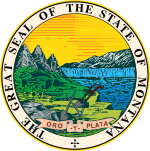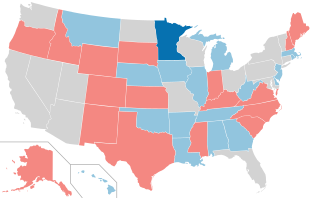
The 1990 United States Senate elections were held on Tuesday, November 6, 1990, with the 33 seats of Class 2 contested in regular elections. Special elections were also held to fill vacancies. The Democratic Party increased its majority with a net gain of one seat from the Republican Party. The election cycle took place in the middle of President George H. W. Bush's term, and, as with most other midterm elections, the party not holding the presidency gained seats in Congress.

The 1976 United States Senate elections was an election for the United States Senate. Held on November 2, the 33 seats of Class 1 were contested in regular elections. They coincided with Democrat Jimmy Carter's presidential election and the United States Bicentennial celebration. Although almost half of the seats decided in this election changed parties, Carter's narrow victory did not provide coattails for the Democratic Party. Each party flipped seven Senate seats, although, one of the seats flipped by Democrats was previously held by a Conservative.

The 1972 United States Senate elections were held on November 7, with the 33 seats of Class 2 contested in regular elections. They coincided with the landslide re-election of Republican President Richard Nixon. Despite Nixon's landslide victory, Democrats increased their majority by two seats. The Democrats picked up open seats in Kentucky and South Dakota, and defeated four incumbent senators: Gordon Allott of Colorado, J. Caleb Boggs of Delaware, Jack Miller of Iowa, and Margaret Chase Smith of Maine. The Republicans picked up open seats in New Mexico, North Carolina, and Oklahoma, and defeated one incumbent, William B. Spong Jr. of Virginia.

The 1964 United States Senate elections were held on November 3. The 33 seats of Class 1 were contested in regular elections. Special elections were also held to fill vacancies. They coincided with the election of President Lyndon B. Johnson by an overwhelming majority, to a full term. His Democratic Party picked up a net two seats from the Republicans. As of 2023, this was the last time either party has had a two-thirds majority in the Senate, which allowed the Senate Democrats to override a veto, propose constitutional amendments, or convict and expel certain officials without any votes from Senate Republicans. However, internal divisions would have prevented the Democrats from having done so. The Senate election cycle coincided with Democratic gains in the House in the same year.

The 1960 United States Senate elections coincided with the election of John F. Kennedy as president on November 8, 1960. The 33 seats of Class 2 were contested in regular elections. A special election was also held on June 28, 1960, for a mid-term vacancy in North Dakota where Democrats flipped a seat to expand their majority to 66–34. As Majority Leader Lyndon Johnson was elected Vice President, Mike Mansfield became the new majority leader.

The 1954 United States Senate elections was a midterm election in the first term of Dwight D. Eisenhower's presidency. The 32 Senate seats of Class 2 were contested in regular elections, and six special elections were held to fill vacancies. Eisenhower's Republican party lost a net of two seats to the Democratic opposition. This small change was just enough to give Democrats control of the chamber with the support of an Independent who agreed to caucus with them, he later officially joined the party in April 1955.

The 1948 United States Senate elections were elections which coincided with the election of Democratic President Harry S. Truman for a full term. The 32 seats of Class 2 were contested in regular elections, and one special election was held to fill a vacancy. Truman had campaigned against an "obstructionist" Congress that had blocked many of his initiatives, and in addition the U.S. economy recovered from the postwar recession of 1946–1947 by election day. Thus Truman was rewarded with a Democratic gain of nine seats in the Senate, enough to give them control of the chamber. This was the last time until 2020 that Democrats flipped a chamber of Congress in a presidential election cycle.
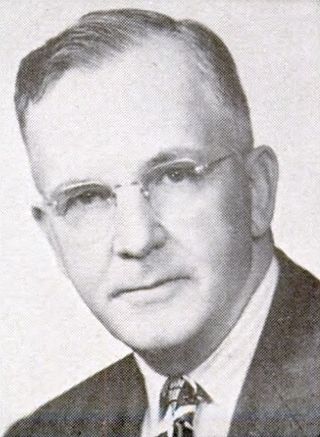
Wesley Abner D'Ewart was a U.S. Republican politician who served in the United States House of Representatives from Montana's 2nd congressional district from June 5, 1945, to January 3, 1955.

John Woodrow Bonner was an American politician who served as the 13th Governor of Montana from January 3, 1949, to January 4, 1953. He was the first Governor of Montana to be born in the 20th century.

The 1924 United States Senate election in Montana took place on November 4, 1924. Incumbent United States Senator Thomas J. Walsh, who was first elected to the Senate in 1912 by the state legislature, and re-elected in 1918 by popular vote, ran for re-election. He was unopposed in the Democratic primary.

The 1930 United States Senate election in Montana took place on November 4, 1930. Incumbent United States Senator Thomas J. Walsh, who was first elected to the Senate in 1912, and re-elected in 1918 and 1924, ran for re-election. He won the Democratic primary unopposed, and faced Montana Supreme Court Associate Justice Albert J. Galen, the Republican nominee, and several independent opponents in the general election. Ultimately, Walsh defeated his opponents in a landslide and won his fourth and final term in the Senate.
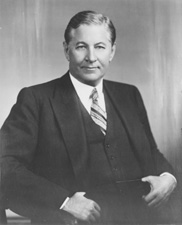
The 1934 United States Senate special election in Montana took place on November 6, 1934. Incumbent United States Senator John E. Erickson, who, as governor, had appointed himself to the seat in 1933 upon the death of Thomas J. Walsh, ran for re-election. However, he was defeated in the Democratic primary by James E. Murray, who was the former Silver Bow County Attorney and the Chairman of the State Advisory Board of the Public Works Administration. In the general election, Murray defeated Scott Leavitt, a former United States Congressman who had represented Montana's 2nd congressional district, and an independent candidate in a landslide to win his first term in the Senate.
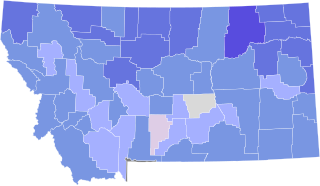
The 1930 United States Senate election in Montana took place on November 3, 1936. Incumbent United States Senator James E. Murray, who was first elected to the Senate in a special election in 1934, ran for re-election. He narrowly emerged from a competitive and close Democratic primary, wherein he was challenged by United States Congressman Joseph P. Monaghan, who represented Montana's 1st congressional district. In the general election, Murray was opposed by Thomas O. Larson, a State Senator and the Republican nominee, and Monaghan, who, after losing the primary, ran as an independent candidate. Murray ended up winning a second term, and his first full term, in a landslide, defeating both of his opponents by a comfortable margin.

The 1942 United States Senate election in Montana took place on November 3, 1942. Incumbent United States Senator James E. Murray, who was first elected to the Senate in a special election in 1934 and was re-elected in 1936, ran for re-election. Following his victory in a competitive Democratic primary, Murray advanced to the general election, where he was opposed by former United States Attorney for the District of Montana Wellington D. Rankin, the Republican nominee and brother of representative Jeannette Rankin. In a closely fought election, Murray narrowly defeated Rankin to win re-election to his third term and his second full term in the Senate.

The 1954 United States Senate election in Montana took place on November 2, 1954. Incumbent United States Senator James E. Murray, who was first elected to the Senate in a special election in 1934 and was re-elected in 1936, 1942, and 1948, ran for re-election. After winning the Democratic primary against trivial opponents, he advanced to the general election, where he was opposed by Wesley A. D'Ewart, the Republican nominee and the United States Congressman from Montana's 2nd congressional district. A contentious and close election ensued, but ultimately, Murray was able to narrowly win re-election over D'Ewart to a final term in the Senate.

The 1960 United States Senate election in Montana took place on November 8, 1960. Incumbent United States Senator James E. Murray, who was first elected to the Senate in a special election in 1934 and was re-elected in 1936, 1942, and 1948, and 1954, declined to seek re-election, creating an open seat. United States Congressman Lee Metcalf won out in a crowded Democratic primary and faced off against former United States Congressman Orvin B. Fjare, who won in a similarly-crowded Republican primary. Following a close general election, Metcalf narrowly defeated Fjare to win his first term in the Senate.

The 1922 United States Senate election in Montana took place on November 7, 1922. Incumbent United States Senator Henry L. Myers, who was first elected to the Senate in 1910, and was re-elected in 1916, declined to seek re-election. Former United States Attorney Burton K. Wheeler won the Democratic primary and advanced to the general election, where he faced Carl W. Riddick, the United States Congressman from Montana's 2nd congressional district and the Republican nominee. Ultimately, Wheeler defeated Riddick comfortably and won his first term in the Senate.

The 1934 United States Senate election in Montana took place on November 6, 1934. Incumbent United States Senator Burton K. Wheeler, who was first elected to the Senate in 1922, and was re-elected in 1928, ran for re-election. After easily winning the Democratic primary, Wheeler moved on to the general election, where he faced George M. Bourquin, a former United States Federal Judge and the Republican nominee. In a stark contrast to his close campaign in 1928, Wheeler won re-election to his third Senate term in a landslide.

The 1940 United States Senate election in Montana took place on November 5, 1940. Incumbent United States Senator Burton K. Wheeler, who was first elected to the Senate in 1922, and was re-elected in 1928 and 1934, ran for re-election. Though he faced a serious challenger in the Democratic primary, he emerged victorious, and advanced to the general election, where he faced E. K. Cheadle, a state district judge and the Republican nominee. Just like in 1934, Wheeler won re-election in a landslide, winning his fourth term in the Senate.
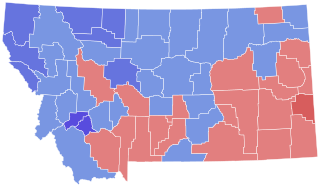
The 1948 Montana gubernatorial election took place on November 2, 1948. Incumbent Governor of Montana Sam C. Ford, who was first elected Governor in 1940 and was re-elected in 1944, ran for re-election. He won the Republican primary and advanced to the general election, where he faced John W. Bonner, the former Attorney General of Montana and the Democratic nominee. Ultimately, Bonner defeated Ford handily in his bid for re-election, winning his first and only term as governor.

